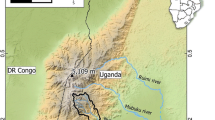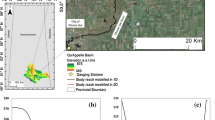Abstract
An evidence-based flood hazard analysis in mountain streams requires the identification and the quantitative characterisation of multiple possible processes. These processes result from specific triggering mechanisms on the hillslopes (i.e. landslides, debris flows), in-channel morphodynamic processes associated with sudden bed changes and stochastic processes taking place at critical stream configurations (e.g. occlusion of bridges, failure of levees). From a hazard assessment perspective, such possible processes are related to considerable uncertainties underlying the hydrological cause-effect chains. Overcoming these uncertainties still remains a major challenge in hazard and risk assessment and represents a necessary condition for a reliable spatial representation of process intensities and the associated probabilities. As a result of an accurate analysis of the conceptual flaws present in the procedures currently employed for hazard mapping in South Tyrol (Italy) and Carinthia (Austria), we propose a structured approach as a means to enhance the integration of hillslope, morphodynamic and stochastic processes into conventional flood hazard prediction for mountain basins. To this aim, a functional distinction is introduced between prevailing one-dimensional and two-dimensional process propagation domains, i.e., between confined and semi- to unconfined stream segments. The former domains are mostly responsible for the generation of water, sediment and wood fluxes, and the latter are where flooding of inactive channel areas (i.e. alluvial fans, floodplains) can occur. For the 1D process propagation domain, we discuss how to carry out a process routing along the stream system and how to integrate numerical models output with expert judgement in order to derive consistent event scenarios, thus providing a consistent quantification of the input variables needed for the associated 2D domains. Within these latter domains, two main types of spatial sub-domains can be identified based on the predictability of their dynamics, i.e., stochastic and quasi-deterministic. Advantages and limitations offered by this methodology are finally discussed with respect to hazard and risk assessment in mountain basins.




Similar content being viewed by others
References
Apel H, Merz B, Thieken AH (2009) Influence of dike breaches on flood frequency estimation. Comput Geosci 35(5):907–923
Autonome Provinz Bozen-Südtirol (2008) Informationssystem zu hydrogeologischen Risiken. Autonome Provinz Bozen-Südtirol, Methodischer Endbericht. Bozen
Barredo J (2007) Major flood disasters in Europe: 1950–2005. Nat Hazards 42(1):125–148
Blazkova S, Beven KJ (2009) Uncertainty in flood estimation. Structure and infrastructure engineering maintenance, management. Life-Cycle Design and Performance 5(4):325–332
Christensen J, Christensen O (2003) Climate modelling: severe summertime flooding in Europe. Nature 421(6925):805–806
Comiti F, Mao L, Preciso E, Picco L, Marchi L, Borga M (2008) Large wood and flash floods: evidences from the 2007 event in the Davča basin (Slovenia). In: De Wrachien D, Brebbia CA, Lenzi MA (eds) Monitoring, simulation, prevention and remediation of dense and debris flow II. WIT Press, Southampton, pp 173–182
Commission of the European Communities (2004) Communication from the Commission to the Council, the European Parliament, the European Economic and Social Committee and the Committee of the Regions—Flood risk management—Flood prevention, protection and mitigation, http://eur-lex.europa.eu/LexUriServ/LexUriServ.do?uri=COM:2004:0472:fin:en:pdf. Access 27 October 2010
Commission of the European Communities (2007) Directive 2007/60/EC of the European parliament and of the council of 23 October 2007 on the assessment and management of flood risks. http://eur-lex.europa.eu/LexUriServ/LexUriServ.do?uri=OJ:L:2007:288:0027:0034:en:pdf. Access 12 October 2010
Eisenführ F, Weber M (2010) Rationales Entscheiden. Springer, Berlin
Fuchs S, McAlpin MC (2005) The net benefit of public expenditures on avalanche defence structures in the municipality of Davos, Switzerland. Nat Haz Earth Syst Sci 5(3):319–330
Fuchs S, Thöni M, McAlpin MC, Gruber U, Bründl M (2007) Avalanche hazard mitigation strategies assessed by cost effectiveness analyses and cost benefit analyses—evidence from Davos, Switzerland. Nat Hazards 41(1):113–129
Funtowicz S, Ravetz J (1994) Uncertainty, complexity and post-normal science. Environ Toxicol Chem 13(12):1881–1885
Gilboa I (2009) Theory of decision under uncertainty. Cambridge University Press, Cambridge
Hoffman FO, Hammonds JS (1994) Propagation of uncertainty in risk assessments: the need to distinguish between uncertainty due to lack of knowledge and uncertainty due to variability. Risk Anal 14(5):707–712
Holub M, Fuchs S (2009) Mitigating mountain hazards in Austria–Legislation, risk transfer, and awareness building. Nat Hazards Earth Syst Sci 9(2):523–537
Huggel C, Kääb A, Haeberli W, Krummenacher B (2003) Regional-scale GIS-models for assessment of hazards from glacier lake outbursts: evaluation and application in the Swiss Alps. Nat Hazards Earth Syst Sci 3(6):647–662
Keiler M, Knight J, Harrison S (2010) Climate change and geomorphological hazards in the eastern European Alps. Philosophical Transactions of the Royal Society of London. Series A: Mathematical, Physical and Engineering Sciences 368:2461–2479
Kienholz H, Keller H, Ammann W, Weingartner R, Germann P, Hegg Ch, Mani P, Rickenmann D (1998) Zur Sensitivität von Wildbachsystemen. vdf Hochschulverlag, Zürich
Kienholz H, Frick E, and Gertsch E (2010) Assessment tools for mountain torrents: SEDEX and bed load assessment matrix. In: Chen SC (ed) Internationales symposion interpraevent in the Pacific Rim—Taipei (26–30 April). Internationale Forschungsgesellschaft Interpraevent, Klagenfurt, pp 245–256
Klein R, Scholl A (2004) Planung und Entscheidung: Konzepte, Modelle und Methoden einer modernen betriebwirtschaftlichen Entscheidungsanalyse. Verlag Franz Vahlen, München
Kolkman M, Kok M, van der Veen A (2005) Mental model mapping as a new tool to analyse the use of information in decision-making in integrated water management. Phys Chem Earth 30(4–5):317–332
Kundzewicz Z, Ulbrich U, Brücher T, Graczyk D, Krüger A, Leckebusch G, Menzel L, Pińskwar I, Radziejewski M, Szwed M (2005) Summer floods in Central Europe—climate change track? Nat Hazards 36(1–2):165–189
Mazzorana B, Fuchs S (2010) Fuzzy formative scenario analysis for woody material transport related risks in mountain torrents. Environmental Modelling and Software 25(10):1208–1224
Mazzorana B, Hübl J, Fuchs S (2009) Improving risk assessment by defining consistent and reliable system scenarios. Nat Hazards Earth Syst Sci 9(1):145–159
Mazzorana B, Hübl J, Zischg A, Largiader A (2011) Modelling woody material transport and deposition in alpine rivers. Nat Hazards 56(2):425–449
Mazzorana B, Comiti F, Volcan C, Scherer C (in press) Determining flood hazard patterns through a combined stochastic–deterministic approach. Natural Hazards. doi:10.1007/s11069-011-9755-2
Mitchell JK (2003) European river floods in a changing world. Risk Anal 23(3):567–574
Paté-Cornell E (1996) Uncertainty in risk analysis: six levels of treatment. Reliability Engineering and System Safety 54(2–3):95–111
Refsgaard J, van der Sluijs J, Højberg A, Vanrolleghem P (2007) Uncertainty in the environmental modelling process—a framework and guidance. Environmental Modelling and Software 22(11):1543–1556
Rigon E, Comiti F, Mao L, Lenzi MA (2008) Relationships among basin area, sediment transport mechanisms and wood storage in mountain basins of the Dolomites (Italian Alps). In: De Wrachien D, Brebbia CA, Lenzi MA (eds) Monitoring, simulation, prevention and remediation of dense and debris flow II. WIT Press, Southampton, pp 163–172
Schäfer M (2006) Computational engineering: introduction to numerical methods. Springer, Berlin
Scholz R, Tietje O (2002) Embedded case study methods. London, Sage
Zischg A, Fuchs S, Keiler M, Stötter, J (2005) Temporal variability of damage potential on roads as a conceptual contribution towards a short-term avalanche risk simulation. Nat Hazards Earth Syst Sci 5(2):235–242
Author information
Authors and Affiliations
Corresponding author
Annex 1: Formative Scenario Analysis procedure:
Annex 1: Formative Scenario Analysis procedure:
-
1.
A team of individuals familiar with the problem setting lists v 1, i = 1, …, N impact variables relevant for the setting, also referred to as system variables, impact factors or case descriptors. The individuals assign every selected impact variable to one of the following categories:
-
Variables describing the inflow characteristics at the homogenous stream segment upstream boundary (US);
-
Variables describing the outflow characteristics at the homogenous stream segment downstream boundary (DS);
-
Variables describing the homogenous stream segment initial conditions (IC);
-
Variables describing the homogenous stream segment adjustment descriptors (AD).
-
The union of the above listed categories represents the entire set of impact variables \( D = US \cup DS \cup IC \cup AD \)
-
2.
In a next step, the individuals define the impact levels for each individual impact variable. Since the combinatorial number of scenarios is considerably influenced by the number of levels defined for each impact variable, impact variables and their levels should be defined parsimoniously. Each impact variable v i requires the definition of at least two discrete levels (N i ≥ 2) which are denoted by \( v_{i}^{1} ,v_{i}^{2} , \ldots ,v_{i}^{{N_{i} }} \).
-
3.
Formally, a scenario is a vector \( S_{k} = \left( {v_{1}^{{n_{1} }} , \ldots ,v_{i}^{{n_{i} }} , \ldots ,v_{N}^{{n_{N} }} } \right) \) with k = 1, …, k 0; the number of scenarios is \( k_{0} = \prod\nolimits_{i = 1}^{N} {N_{i} } \).
-
4.
In this step, the consistency matrix is constructed as \( C = \left[ {c\left( {v_{i}^{{n_{i} }} ,v_{j}^{{n_{j} }} } \right)} \right] \) containing the consistency ratings, c(.,.), for all pairs of impact variables at all levels c, \( \left( {i,j = 1, \ldots ,N,i \ne j,n_{i} = 1, \ldots ,N_{i} ,n_{j} = 1, \ldots ,N_{j} } \right) \).
-
5.
For each scenario a consistency value is calculated respectively as additive measure as \( c^{*} \left( {S_{k} } \right) = \sum {c\left( {v_{i}^{{n_{i} }} ,v_{j}^{{n_{j} }} } \right)} \) or as multiplicative measure as \( c^{*} \left( {S_{k} } \right) = \prod {c\left( {v_{i}^{{n_{i} }} ,v_{j}^{{n_{j} }} } \right)} \) with \( i,j = 1, \ldots ,N,i \ne j,v_{i}^{{n_{i} }} ,v_{j}^{{n_{j} }} \in S_{k} \).
-
6.
The scenario selection is based conjointly on the consistency value of the scenarios and the difference between them. The distance measure Δ corresponds to the number of differences between the scenarios \( \Updelta \left( {S_{k} ,S_{l} } \right) = \sum\nolimits_{i = 1}^{n} {\left\{ {\begin{array}{*{20}c} 1 & {{\text{if }}v_{i} \left( {S_{k} } \right) \ne v_{i} \left( {S_{l} } \right)} \\ 0 & {\text{otherwise}} \\ \end{array} } \right.} \). The scenarios are ranked in decreasing order according to consistency in an array. The scenario with the highest consistency value S k is selected from the array and compared with the second scenario S l . If Δ(S k , S l ) is sufficiently large, e.g. Δ(S k , S l ) ≥ Δ*, where Δ* was a chosen threshold value, then scenario S l is also selected and becomes the new comparison reference for scenario three, otherwise the third scenario is compared with the first scenario, etc.
-
7.
Scenario interpretation completes the adapted steps of Formative Scenario Analysis
Rights and permissions
About this article
Cite this article
Mazzorana, B., Comiti, F. & Fuchs, S. A structured approach to enhance flood hazard assessment in mountain streams. Nat Hazards 67, 991–1009 (2013). https://doi.org/10.1007/s11069-011-9811-y
Received:
Accepted:
Published:
Issue Date:
DOI: https://doi.org/10.1007/s11069-011-9811-y




